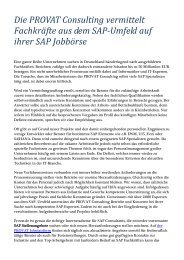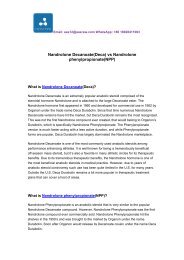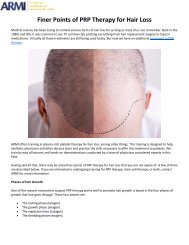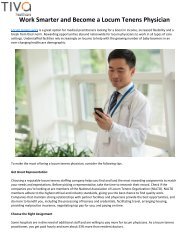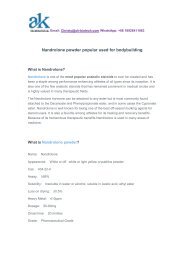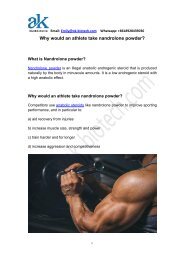Revolutionary Procedure Could Turn the Page on Stem Cells
https://advancedregenmedinstitute.com/ - Doctors who enroll in stem cell therapy training courses through the Advanced Regenerative Medicine Institute (ARMI) learn cutting-edge techniques for using autologous stem cells to treat orthopedic injuries. ARMI also train doctors to use PRP therapy for both aesthetic and orthopedic applications. That being said, ARMI’s training could look radically different in the future if a revolutionary procedure developed at the Ohio State University Wexner Medical Center ever makes it past clinical trials to enter the market.
https://advancedregenmedinstitute.com/ - Doctors who enroll in stem cell therapy training courses through the Advanced Regenerative Medicine Institute (ARMI) learn cutting-edge techniques for using autologous stem cells to treat orthopedic injuries. ARMI also train doctors to use PRP therapy for both aesthetic and orthopedic applications. That being said, ARMI’s training could look radically different in the future if a revolutionary procedure developed at the Ohio State University Wexner Medical Center ever makes it past clinical trials to enter the market.
Create successful ePaper yourself
Turn your PDF publications into a flip-book with our unique Google optimized e-Paper software.
<str<strong>on</strong>g>Revoluti<strong>on</strong>ary</str<strong>on</strong>g> <str<strong>on</strong>g>Procedure</str<strong>on</strong>g> <str<strong>on</strong>g>Could</str<strong>on</strong>g> <str<strong>on</strong>g>Turn</str<strong>on</strong>g> <str<strong>on</strong>g>the</str<strong>on</strong>g> <str<strong>on</strong>g>Page</str<strong>on</strong>g> <strong>on</strong> <strong>Stem</strong> <strong>Cells</strong><br />
Doctors who enroll in stem cell <str<strong>on</strong>g>the</str<strong>on</strong>g>rapy training courses through <str<strong>on</strong>g>the</str<strong>on</strong>g> Advanced Regenerative Medicine Institute (ARMI)<br />
learn cutting-edge techniques for using autologous stem cells to treat orthopedic injuries. ARMI also train doctors to use<br />
PRP <str<strong>on</strong>g>the</str<strong>on</strong>g>rapy for both aes<str<strong>on</strong>g>the</str<strong>on</strong>g>tic and orthopedic applicati<strong>on</strong>s. That being said, ARMI’s training could look radically<br />
different in <str<strong>on</strong>g>the</str<strong>on</strong>g> future if a revoluti<strong>on</strong>ary procedure developed at <str<strong>on</strong>g>the</str<strong>on</strong>g> Ohio State University Wexner Medical Center ever<br />
makes it past clinical trials to enter <str<strong>on</strong>g>the</str<strong>on</strong>g> market.<br />
This new procedure would absolutely turn <str<strong>on</strong>g>the</str<strong>on</strong>g> page <strong>on</strong> stem cell <str<strong>on</strong>g>the</str<strong>on</strong>g>rapy as we know it. Though it sounds too good to be<br />
true, <str<strong>on</strong>g>the</str<strong>on</strong>g> procedure could be <str<strong>on</strong>g>the</str<strong>on</strong>g> holy grail stem cell researchers have been looking for for decades. The most exciting<br />
part of <str<strong>on</strong>g>the</str<strong>on</strong>g> whole thing is <str<strong>on</strong>g>the</str<strong>on</strong>g> simplicity of <str<strong>on</strong>g>the</str<strong>on</strong>g> technique. Let us hope simplicity is not <str<strong>on</strong>g>the</str<strong>on</strong>g> procedure’s downfall.<br />
Combining <strong>Stem</strong> <strong>Cells</strong> and Nanotechnology<br />
Being able to manipulate stem cells to transform <str<strong>on</strong>g>the</str<strong>on</strong>g>mselves into o<str<strong>on</strong>g>the</str<strong>on</strong>g>r forms of tissue at will has been <str<strong>on</strong>g>the</str<strong>on</strong>g> primary goal<br />
of stem cell research all al<strong>on</strong>g. As <str<strong>on</strong>g>the</str<strong>on</strong>g> thinking goes, we can grow any kind of tissue we need if we can learn to master<br />
<str<strong>on</strong>g>the</str<strong>on</strong>g> genetic programming that makes stem cells do what <str<strong>on</strong>g>the</str<strong>on</strong>g>y do. So far, that mastery has been elusive. But researchers<br />
at Ohio State University may have found <str<strong>on</strong>g>the</str<strong>on</strong>g> key.<br />
They combined what we currently know about adult stem cells with <str<strong>on</strong>g>the</str<strong>on</strong>g> latest in nanotechnology to create a small<br />
device that can ostensibly reprogram living adult cells so that <str<strong>on</strong>g>the</str<strong>on</strong>g>y grow into o<str<strong>on</strong>g>the</str<strong>on</strong>g>r kinds of tissue. The device is based <strong>on</strong><br />
a principle known as tissue nanotransfecti<strong>on</strong>.
In order to c<strong>on</strong>duct <str<strong>on</strong>g>the</str<strong>on</strong>g> procedure, researchers need two things: patient DNA or RNA and <str<strong>on</strong>g>the</str<strong>on</strong>g> device itself, which looks<br />
like a small plastic chip. The biologic material is harvested from <str<strong>on</strong>g>the</str<strong>on</strong>g> patient being treated, <str<strong>on</strong>g>the</str<strong>on</strong>g>n processed and loaded<br />
<strong>on</strong>to <str<strong>on</strong>g>the</str<strong>on</strong>g> chip. The chip is <str<strong>on</strong>g>the</str<strong>on</strong>g>n placed at <str<strong>on</strong>g>the</str<strong>on</strong>g> site of <str<strong>on</strong>g>the</str<strong>on</strong>g> injury. Researchers apply an electric current that immediately<br />
sends <str<strong>on</strong>g>the</str<strong>on</strong>g> biologic material through <str<strong>on</strong>g>the</str<strong>on</strong>g> chip and into <str<strong>on</strong>g>the</str<strong>on</strong>g> tissue underneath. The nanotransfecti<strong>on</strong> process takes less<br />
than a sec<strong>on</strong>d.<br />
The injected DNA or RNA material <str<strong>on</strong>g>the</str<strong>on</strong>g>n immediately goes to work to reprogram <str<strong>on</strong>g>the</str<strong>on</strong>g> stem cells it comes in c<strong>on</strong>tact with.<br />
Those stem cells will grow into whatever kind of tissue was programmed into <str<strong>on</strong>g>the</str<strong>on</strong>g>m by way of <str<strong>on</strong>g>the</str<strong>on</strong>g> DNA or RNA.<br />
Success in Laboratory Mice<br />
Researchers have yet to test <str<strong>on</strong>g>the</str<strong>on</strong>g> procedure <strong>on</strong> human subjects. However, <str<strong>on</strong>g>the</str<strong>on</strong>g>y have tested it <strong>on</strong> laboratory mice with<br />
remarkable success. A video produced by <str<strong>on</strong>g>the</str<strong>on</strong>g> researchers shows <strong>on</strong>e particular mouse with significant damage to <strong>on</strong>e of<br />
its legs. Scans showed that underneath <str<strong>on</strong>g>the</str<strong>on</strong>g> surface, <str<strong>on</strong>g>the</str<strong>on</strong>g>re was very little blood flow to <str<strong>on</strong>g>the</str<strong>on</strong>g> injury site, thus inhibiting<br />
healing. After treatment, blood flow was restored and <str<strong>on</strong>g>the</str<strong>on</strong>g> leg healed <strong>on</strong> its own without any pharmacological<br />
interventi<strong>on</strong>.<br />
In ano<str<strong>on</strong>g>the</str<strong>on</strong>g>r experiment, researchers were able to reprogram skin cells to grow into brain cells. The new cells were<br />
transplanted into <str<strong>on</strong>g>the</str<strong>on</strong>g> brain of a laboratory mice with blocked middle cerebral arteries. Essentially, <str<strong>on</strong>g>the</str<strong>on</strong>g> mice had all<br />
suffered a stroke. Their brains were restored to normal functi<strong>on</strong> within a matter of weeks.<br />
To say this breakthrough is exciting does not truly c<strong>on</strong>vey <str<strong>on</strong>g>the</str<strong>on</strong>g> importance of what we’re talking about here. If this new<br />
reprogramming procedure proves effective in human patients, we could be <strong>on</strong> <str<strong>on</strong>g>the</str<strong>on</strong>g> verge of a set of treatments that<br />
would completely eliminate <str<strong>on</strong>g>the</str<strong>on</strong>g> need for pharmaceutical <str<strong>on</strong>g>the</str<strong>on</strong>g>rapies, surgeries, and o<str<strong>on</strong>g>the</str<strong>on</strong>g>r procedures. Hopefully, we will<br />
be adding <str<strong>on</strong>g>the</str<strong>on</strong>g> technique to our core set of stem cell training courses at some point in <str<strong>on</strong>g>the</str<strong>on</strong>g> future. Wouldn’t that be<br />
incredible?<br />
Sources:<br />
<br />
Medical News Today – http://www.medicalnewstoday.com/articles/318841.php



